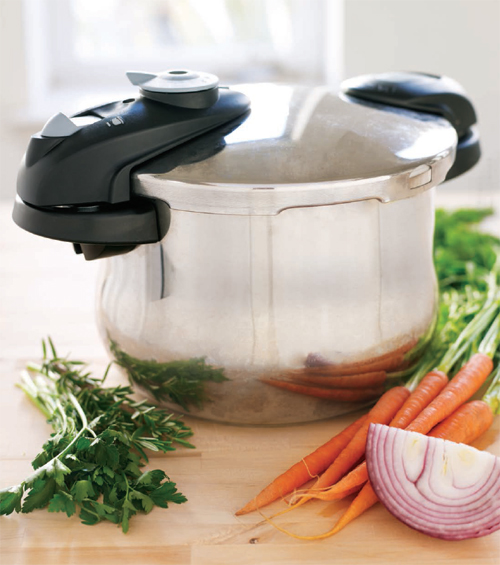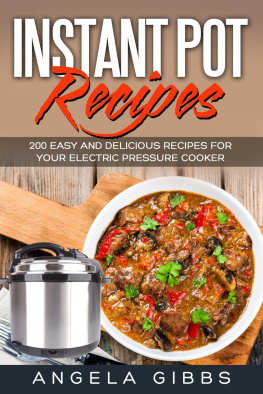Because everything cooks faster in a pressure cooker, and only a small amount of liquid is needed, fewer nutrients are leached or evaporated away as they are in other types of cooking. Some people have a cooker on hand just to make high-fiber, protein-rich beans weekly or even daily, or to cook whole-grain brown rice or farro at the last minute, both of which contribute to a healthy lifestyle.
The pressure cooker isnt a new tool, but it is a completely redesigned one. The original models were variations on large, pressurized canning kettles that became popular around the time of the first World War. Manufacturers saw the potential to adapt these for home cooking. Soon, the pressure cooker was the appliance of the moment and vendors across the country rushed inexpensive versions to market to meet demand.
When World War II came along, most manufacturers retooled their factories to help the war effort. Pressure cookers were put on the back burner, so to speak, and new pots werent introduced. Older pots stayed in use too long, which is why some people have bad memories of them. These were the ones with ominous jiggling valves and sinister hissing steamthe ones Mom struggled with to unscrew the lid. Worse yet, stories circulated about being scalded or tomato sauce on the kitchen ceiling when the top blew. Then there was the food: uniformly bland, overcooked, and pallid. Needless to say, pressure cookers faded out of fashion in America. In Europe however, cooks continued to use the pots to prepare traditional slow-cooked dishes in much less time, and manufacturers there continued to update the models and make them better. There, the technology evolved, as did the quality of recipes associated with pressure cooking.
Back in the US, demand for cooking shortcuts never faded, so smart manufacturers revisited pressure cookers in the 1980s, employing improved technology to eliminate mishaps. Todays pressure cookers have built-in safety features, including secure pressure-regulator valves and at least three backup systems to release steam in the event of a blockage. A modern stove-top pressure cooker simply cannot be opened while still cooking under pressure.
ABOUT OLDER PRESSURE COOKERS
If you already own a pressure cooker that was made in the last decade or so, it may be fine to use, but you will need to check that the gasket or sealing ring is not dried, cracked, or worn out; that you have all the parts in good working order; and that you have the instruction manual. If you are missing anything or have doubts, contact the manufacturer. Your best bet may be to invest in a new one.
Once these new-and-improved pressure cookers came to market and received rave reviews, demand went up. As a result, there was a boom in cookbooks and food articles with intriguing recipes to make in the pots: think beer-braised chicken, beef stroganoff, and scalloped potatoes. Recipes from overseas migrated here, too: Bolognese sauce, braised fennel, and even risotto. Gradually, cooks everywhere adapted their own recipes to pressure cooking so that now there are countless Web sites dedicated to the appliance and its many uses and fans. Recently, electric pressure cookers have been introduced, adding increased safety, convenience, and ease for the home cook.
As mentioned before, part of the pressure cookers popularity is the increased awareness today of health and whole foods. Theres an environmentally friendly aspect to cooking under pressure, too. Because it takes far less time to cook a dish, less gas or electricity is used. And saving energy is good for everyone.
WHY USE A PRESSURE COOKER?
Contemporary models are safe and reliable
Less cooking time means more energy saved
Healthy foods, such as whole grains, beans, and legumes, cook quickly, while retaining more nutrients
Comfort foods can be prepared on a weeknight schedule
Vegetables, potatoes, and even risotto need no tending when cooked under pressure
Dishes cook in one third to one half the time
WHAT SIZE POT?
Pressure cookers today come in a range of sizes, but for the average household, a six-quart pressure cooker is the most convenient, multi-purpose size.

the right pressure cooker for you
With the various types of pressure cookers on the market today, both stove top and electric models, cooking under pressure is just a shopping trip away. Your decision on which model to choose will probably be based on three factors: which size pot suits your household; price; and the amount of storage space in your kitchen. Both types of pressure cookers have advantages and either is a good choice. Its a matter of individual taste and preference.
Stove-top pressure cookers Stove-top models are generally available in aluminum or stainless steel, the former being more inexpensive and lightweight, the latter being of a heavier gauge and costing slightly more. While the choice is individual, the recommendation is the same as with all pots and pans: a heavy, durable metal with a sturdy base will distribute heat evenly, yield good results, and last for a long time. Stainless steel pots provide all these qualities. Plus, they often have the advantage over aluminum pots of being dishwasher safe.



















